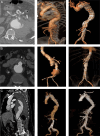Endovascular Repair of 100 Urgent and Emergent Free or Contained Thoracoabdominal Aortic Aneurysms Ruptures. An International Multicenter Trans-Atlantic Experience
- PMID: 38323417
- PMCID: PMC11809711
- DOI: 10.1097/SLA.0000000000006231
Endovascular Repair of 100 Urgent and Emergent Free or Contained Thoracoabdominal Aortic Aneurysms Ruptures. An International Multicenter Trans-Atlantic Experience
Abstract
Objective: To analyze the outcomes of urgent/emergent endovascular aortic repair of patients with free/contained ruptured thoracoabdominal aortic aneurysms (rTAAA).
Background: Endovascular repair of rTAAA has been scarcely described in emergent setting.
Methods: An international multicenter retrospective observational study (ClinicalTrials.govID:NCT05956873) from January 2015 to January 2023 in 6 European and 1 US Vascular Surgery Centers. Primary end points were technical success, 30-day and/or in-hospital mortality, and follow-up survival.
Results: A total of 100 rTAAA patients were included (75 male; mean age 73 years). All patients (86 contained and 14 free ruptures) were symptomatic and treated within 24 hours from diagnosis: multibranched off-the-shelf devices (Zenith t-branch, Cook Medical Inc., Bjaeverskov, Denmark) in 88 patients, physician-modified endografts in 8, patient-specific device or parallel grafts in 2 patients each. Primary technical success was achieved in 89 patients, and 30-day and/or in-hospital mortality was 24%. Major adverse events occurred in 34% of patients (permanent dialysis and paraplegia in 4 and 8 patients, respectively). No statistical differences were detected in mortality rates between free and contained ruptured patients (43% vs 21%; P =0.075). Multivariate analysis revealed contained rupture favoring technical success [odds ratio (OR): 10.1; 95% CI: 3.0-33.6; P <0.001]. Major adverse events (OR: 9.4; 95% CI: 2.8-30.5; P <0.001) and pulmonary complications (OR: 11.3; 95% CI: 3.0-41.5; P <0.001) were independent risk factors for 30-day and/or in-hospital mortality. The median follow-up time was 13 months (interquartile range 5-24); 1-year survival rate was 65%. Aneurysm diameter >80 mm (hazard ratio: 2.0; 95% CI: 1.0-30.5; P =0.037), technical failure (hazard ratio: 2.6; 95% CI: 1.1-6.5; P =0.045) and pulmonary complications (hazard ratio: 3.0; 95% CI: 1.2-7.9; P =0.021) were independent risk factors for follow-up mortality.
Conclusions: Endovascular repair of rTAAA shows high technical success; the presence of free rupture alone appear not to correlate with early mortality. Effective prevention/management of postoperative complications is crucial for survival.
Copyright © 2024 The Author(s). Published by Wolters Kluwer Health, Inc.
Conflict of interest statement
M.G., E.G., N.T., T.K., N.D., and G.O. are consultants for Cook Medical for fenestrated/branched endovascular aneurysm repair. The remaining authors report no conflicts of interest.
Figures


References
-
- Crawford ES, DeNatale RW. Thoracoabdominal aortic aneurysm: observations regarding the natural course of the disease. J Vasc Surg. 1986;3:578–582. - PubMed
-
- Coselli JS, LeMaire SA, Preventza O, et al. . Outcomes of 3309 thoracoabdominal aortic aneurysm repairs. J Thorac Cardiovasc Surg. 2016;151:1323–1338. - PubMed
-
- Moulakakis KG, Karaolanis G, Antonopoulos CN, et al. . Open repair of thoracoabdominal aortic aneurysms in experienced centers. J Vasc Surg. 2018;68:634–645.e12. - PubMed
-
- Tsilimparis N, Perez S, Dayama A, et al. . Endovascular repair with fenestrated-branched stent grafts improves 30-day outcomes for complex aortic aneurysms compared with open repair. Ann Vasc Surg. 2013;27:267–273. - PubMed
Publication types
MeSH terms
Associated data
LinkOut - more resources
Full Text Sources
Medical

